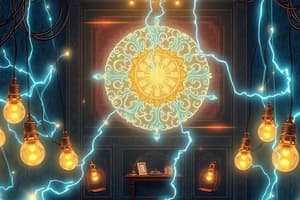Podcast
Questions and Answers
A conductor is a material that does not allow electric current to flow.
A conductor is a material that does not allow electric current to flow.
False (B)
Electric current is measured in volts (V).
Electric current is measured in volts (V).
False (B)
In a parallel circuit, the voltage across each component is different.
In a parallel circuit, the voltage across each component is different.
False (B)
In a series circuit, all components share the same current.
In a series circuit, all components share the same current.
Using appropriate fuses and circuit breakers is unnecessary in ensuring electrical safety.
Using appropriate fuses and circuit breakers is unnecessary in ensuring electrical safety.
CPR and first aid knowledge is not important in dealing with potential electrical shock cases.
CPR and first aid knowledge is not important in dealing with potential electrical shock cases.
Insulators like rubber and glass conduct electricity.
Insulators like rubber and glass conduct electricity.
Electric current flows from the power source to the components and back to the source in an electrical circuit.
Electric current flows from the power source to the components and back to the source in an electrical circuit.
Water conducts electricity, which can pose a serious hazard when it comes into contact with electrical components.
Water conducts electricity, which can pose a serious hazard when it comes into contact with electrical components.
Analyzing complex circuits often requires the use of Ohm's Law and voltage analysis.
Analyzing complex circuits often requires the use of Ohm's Law and voltage analysis.
Study Notes
Electricity and Circuits: A Comprehensive Overview
Electricity and circuits are interconnected concepts that form the backbone of our modern world. In this article, we'll delve into the basics of electrical circuits, their components, different types, electricity safety, and electric current.
Electrical Circuits
An electrical circuit is a closed pathway where electric current flows from a power source, through conducting wires and components, and back to the source. The components in a circuit, such as resistors, capacitors, and batteries, influence the behavior of the current.
Conductors and Insulators
Conductors are materials that allow electric current to flow freely. Common conductors include metals like copper and aluminum. Insulators, on the other hand, do not conduct electricity. Examples of insulators are rubber, glass, and air.
Types of Circuits
There are several types of electrical circuits, each with its own characteristics and applications:
-
Series Circuit: A series circuit contains only one path for current to flow. All components in a series circuit share the same current, and their voltages add up.
-
Parallel Circuit: A parallel circuit has multiple paths for current to flow. In a parallel circuit, the voltage across each component is the same as the voltage across the power source, and the current through each component is determined by the component's resistance.
-
Complex Circuits: These circuits consist of a combination of series and parallel components. Analyzing complex circuits often requires the use of Kirchhoff's laws and nodal analysis.
Electric Current
Electric current is the flow of electric charge through a conductor. It is usually measured in amperes (A). Electric current is directly proportional to the number of charged particles (electrons) passing through a cross-sectional area of the conductor per second.
Electricity Safety
Electricity can be a dangerous and potentially lethal force. To ensure safety, follow these guidelines:
-
Check for damage: Inspect wiring, cords, and plugs for damage before use. Replace or repair any damaged components.
-
Use appropriate fuses and circuit breakers: Fuses and circuit breakers help to protect electrical components and prevent overload.
-
Keep electrical components dry: Water conducts electricity, presenting a serious hazard when it comes into contact with wiring, appliances, or other electrical components.
-
Follow safety guidelines: Always follow labeling and safety guidelines on appliances and equipment.
-
Learn CPR and first aid: In case of electrical shock, be prepared to administer CPR and first aid.
-
Keep up-to-date: Stay informed about the latest electrical safety standards and regulations.
Conclusion
Understanding electrical circuits is foundational to comprehending the world of electricity. This knowledge can empower you to safely navigate and make the most of the technology that surrounds us in our daily lives. Remember, safety first, and always be cautious when dealing with electrical components and circuits. "Circuits and Electricity." National Aeronautics and Space Administration, NASA.gov, https://spaceplace.nasa.gov/circuits-and-electricity/ "Electrical Safety." National Electrical Manufacturers Association, NEMA.org, https://www.nema.org/resources/electrical-safety/
Studying That Suits You
Use AI to generate personalized quizzes and flashcards to suit your learning preferences.
Description
Test your knowledge on electricity and circuits with this comprehensive quiz covering topics such as electrical circuits, conductors and insulators, types of circuits, electric current, and electricity safety measures.




